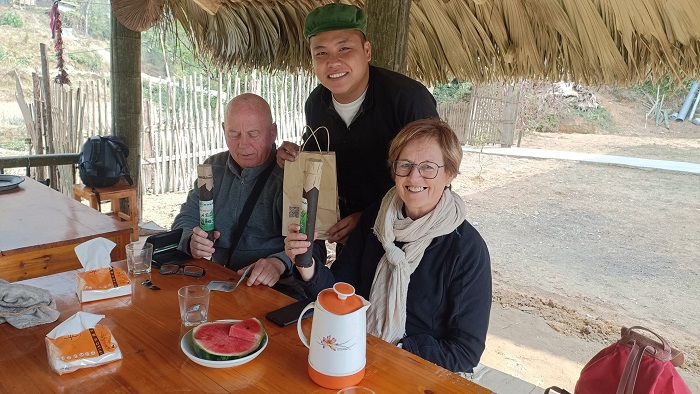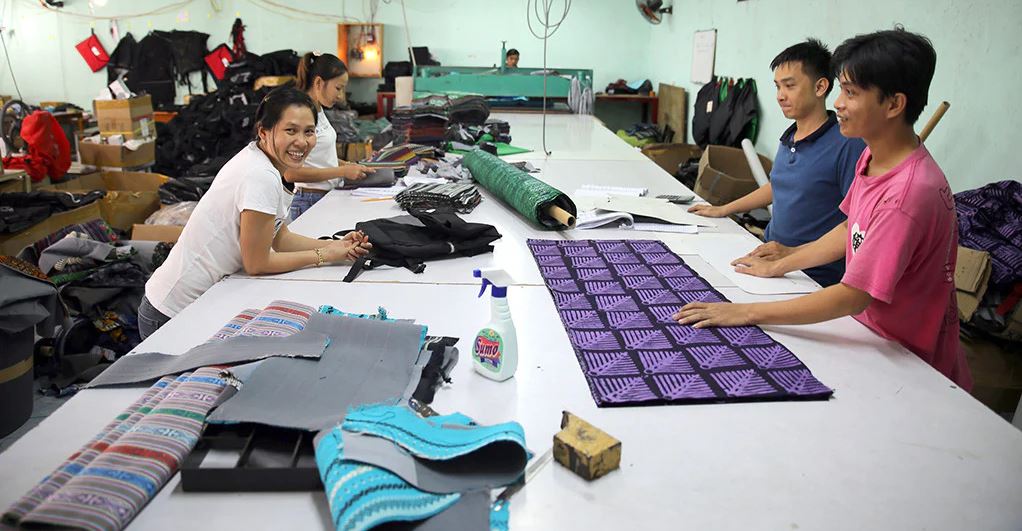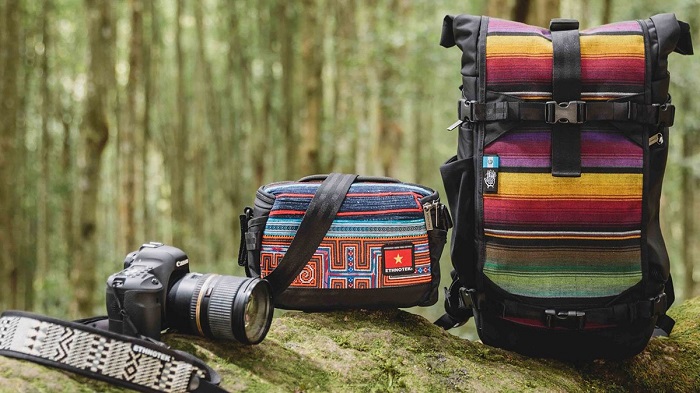Digital transformation is creating a revolution in how we preserve and utilize cultural heritage. Technology is not just a supportive tool but also opens up entirely new approaches.

Vang A Binh at Ban Lien Homestay Offers Bamboo-Tube Tea to International Guests
Photo: Provided by NVCC
On a chilly afternoon in Ban Lien, where the mountains of Northwest Vietnam mingle with the fragrance of ancient Shan Tuyet tea trees, an international guest carefully approached the kitchen of a traditional stilt house. He gently took down a smoked bamboo tube of tea from above the fire, carefully split the bamboo, and extracted a handful of dried tea leaves.
By the fire’s flickering glow, a group of guests gathered around, watching as he placed the tea into a pot, poured water, and waited for the first drops to brew. They enjoyed the tea in warmth, without needing much language or elaborate explanations. Through their expressions of delight and the way they savored the tea’s aroma, they conveyed everything. The story of tea went beyond taste—it touched emotions.
This very moment led to over 100 orders of Shan Tuyet smoked bamboo tea within 24 hours of the story being shared on social media. This is not only a success story in business but also a vivid testament to the potential of cultural heritage when integrated with digital technology.
Sustainable Business Built on Cultural Heritage
Ethnotek, a social enterprise founded by Jake and Cori Orak in 2010, has discovered a way to preserve cultural heritage through the production of high-end bags that incorporate handcrafted fabrics from artisan communities worldwide, including Vietnam, Ghana, Guatemala, India, and Indonesia.
The inspiration for Ethnotek came from Jake Orak’s travels to Vietnam in 2007, where he was captivated by the intricate handcrafted textiles created by local artisans. Recognizing the risk of these traditional techniques disappearing due to industrialization, he decided to build a business model that would generate economic value while preserving and enhancing these heritages.
Ethnotek stands out with its Threads concept—interchangeable and customizable fabric panels attached to the exterior of backpacks, woven by craft villages in Vietnam, Indonesia, Ghana, India, and beyond. This idea not only creates highly personalized products but also allows customers to directly support various artisan communities. All Ethnotek products are manufactured at a single facility in Vietnam, utilizing a centralized process to minimize environmental impact and ensure quality.
Leveraging Digital Technology to Preserve and Promote Culture

Ethnotek combines traditional craftsmanship with digital technology to enhance value.
-
Sharing cultural stories through online platforms: The brand uses social media, its website, and e-commerce platforms to share stories about artisans, traditional weaving techniques, and the journey of the fabrics to customers. This raises awareness about cultural heritage while fostering a connection between customers and artisan communities.
-
Creating a global community: Ethnotek refers to its customers as "tribe members," encouraging them not only to purchase products but also to participate in the movement to preserve culture. Technology has helped connect thousands worldwide with the shared goal of sustaining cultural heritage through practical and sustainable products.
-
Developing sustainable products: Ethnotek utilizes recycled materials and incorporates technology in production and supply chain management to minimize environmental impact, creating products that combine cultural and environmental value.
Cultural Heritage in the Experience Economy
The stories of Ban Lien and Ethnotek highlight a clear trend: cultural heritage is no longer merely something to be preserved but has become an essential part of the experience economy. As consumers seek not only products but also emotionally engaging experiences, traditional cultural values become increasingly valuable.
Vietnam, ranked 24th globally for cultural heritage richness (according to U.S. News & World Report), possesses untapped potential. Traditional values such as Shan Tuyet tea from the Northwest, Dong Ho paintings, and craft villages offer a foundation for creating unique products and experiences that cater to modern consumption trends.
Digital Technology: Redefining Approaches to Heritage
Digital transformation is redefining how we approach cultural heritage preservation and utilization. Technology is not just a tool but a gateway to entirely new possibilities. For instance, the Louvre Museum uses virtual reality (VR) to allow millions worldwide to visit remotely, while the Virtual Angkor project recreates the ancient city of Angkor Wat at its peak, enabling users to not only explore history but immerse themselves in the narratives of the past.
Technologies like VR, augmented reality (AR), and artificial intelligence (AI) not only revive cultural values but also bring them closer to younger generations accustomed to digital experiences. Heritage-based enterprises thus expand their customer reach, transcending geographical boundaries to achieve global impact.
New Business Models Based on Cultural Heritage
Business models are not just about creating and capturing value but also adapting to societal changes and consumer demands. In the context of cultural heritage, new business models are emerging along two main directions:
-
Revitalizing existing models by enhancing cultural value through technology: In the story of Ban Lien, sharing emotionally rich tea experiences on social media instantly created a strong connection with consumers using digital tools.
-
Developing entirely new business models that leverage technology to create unique products and services: Venice Time Machine serves as an exemplary project, digitizing historical records from the 14th to 19th centuries into a digital database, which not only aids research but also unlocks significant potential for digital tourism.
Meeting the Expectations of Modern Consumers
The rise of Gen Z and Millennials, with their high demand for personalized and digital experiences, is driving businesses to innovate continuously. These consumers seek not only quality products but also meaningful experiences that connect them to culture and emotions.
The story of Ban Lien is a vivid illustration of how a simple, culturally rich experience can resonate with customers. Meanwhile, larger initiatives like Virtual Angkor and Venice Time Machine demonstrate that when technology intertwines with culture, the resulting value is limitless.
The Importance of Developing Digital Business Models
Developing business models based on cultural heritage is not just a business strategy but also a national strategic priority. Vietnam, ranked 43rd among 89 countries with dynamic startup ecosystems, has a significant opportunity to foster innovative businesses grounded in cultural heritage. This strategy brings several benefits:
-
International expansion of small businesses: Particularly in experiential tourism and handicrafts, businesses can reach international markets more effectively.
-
Attracting investment: Highlighting the economic value generated by these models will attract both domestic and foreign investment. Expanding global customer reach through digital platforms will also elevate Vietnam's position in the global experience economy.
-
Global collaboration: This approach can attract international technology talent to Vietnam, fostering collaboration with Vietnamese communities to preserve and promote cultural values.
Opportunities from Culture and Technology
The stories of Ban Lien and Ethnotek are small examples in the larger picture of cultural heritage’s potential when combined with digital technology and entrepreneurial spirit. With its rich cultural resources, Vietnam can create business models that are not only economically successful but also help preserve and promote traditional values. This approach is not only a way to safeguard heritage but also a pathway for Vietnam to assert itself in the global economy.
Vietnam, with its diversity in tangible and intangible cultural heritage, can draw inspiration from Ethnotek to develop new business models. Craft villages such as brocade weaving in the Northwest, Bat Trang ceramics, and Van Phuc silk are valuable resources for creating highly personalized and high-value products. When integrated with digital technology—such as e-commerce, AR/VR, and online marketing campaigns—these products can reach not only the domestic market but also international customers.
Risks and Challenges to Consider
However, leveraging digital technology for cultural heritage also poses significant challenges, particularly regarding intellectual property:
-
Risk of copyright infringement: When cultural heritage is digitized, it is vulnerable to unauthorized copying and use by third parties. This not only results in economic loss but also diminishes the value of the original heritage.
-
Ownership disputes: Some global cases have reported intangible heritage being copyrighted by foreign organizations or individuals, complicating efforts to protect the rights of artisan communities.
-
Lack of clear legal frameworks: In Vietnam, intellectual property protection in the field of digital culture remains underdeveloped, leaving small businesses and individuals vulnerable to disputes or lawsuits.
Conclusion
Digital transformation is redefining the boundaries of cultural heritage preservation and utilization. By blending tradition with innovation, Vietnam has the potential to establish itself as a leader in the global experience economy. To achieve this, strategic investments in intellectual property protection, sustainable business models, and technological innovation are crucial.
The opportunities are immense, but so are the challenges. To fully realize the potential of cultural heritage in the digital age, collaboration between artisans, entrepreneurs, technologists, and policymakers will be key. This holistic approach will not only preserve Vietnam’s rich heritage but also position it as a vital player in the global economy of culture and innovation.
Trong một buổi chiều se lạnh tại Bản Liền, nơi núi rừng Tây Bắc hòa quyện cùng hương trà Shan tuyết cổ thụ, một người khách nước ngoài cẩn thận bước đến gác bếp của căn nhà sàn truyền thống. Ông đưa tay nhấc xuống một ống trà tre hun khói, nhẹ nhàng chẻ ống lam, và lấy ra một ít trà khô.
Trong bếp, ánh lửa bập bùng, nhóm khách quây quần xung quanh, quan sát ông cho trà vào ấm, rót nước, và chờ đợi những giọt đầu tiên. Mọi người thưởng trà trong sự ấm cúng, không cần nhiều ngôn ngữ, không cần thuyết minh cầu kỳ. Chỉ bằng ánh mắt đầy thích thú, cách cảm nhận mùi hương trà của họ đã truyền tải tất cả. Câu chuyện về trà không chỉ dừng lại ở vị giác mà còn chạm đến cảm xúc.
Chính khoảnh khắc này đã mang lại hơn 100 đơn hàng trà Shan tuyết ống lam gác bếp chỉ trong vòng 24 giờ sau khi câu chuyện được chia sẻ trên mạng xã hội. Đây không chỉ là câu chuyện về sự thành công trong kinh doanh, mà còn là minh chứng sống động cho tiềm năng của văn hóa di sản khi được kết hợp với công nghệ số.
Kinh doanh bền vững dựa trên di sản văn hóa
Ethnotek, một công ty trách nhiệm xã hội do Jake và Cori Orak sáng lập vào năm 2010, đã tìm ra cách bảo tồn di sản văn hóa thông qua việc sản xuất túi xách cao cấp tích hợp các loại vải thủ công từ các cộng đồng nghệ nhân trên khắp thế giới, bao gồm Việt Nam, Ghana, Guatemala, Ấn Độ, và Indonesia.
Cảm hứng thành lập Ethnotek bắt nguồn từ chuyến du lịch của Jake Orak đến Việt Nam vào năm 2007, nơi ông bị mê hoặc bởi những loại vải thủ công tinh xảo được dệt bởi các nghệ nhân bản địa. Nhận thấy nguy cơ các kỹ thuật truyền thống này có thể biến mất do công nghiệp hóa, ông quyết định xây dựng một mô hình kinh doanh không chỉ mang lại giá trị kinh tế mà còn duy trì và phát huy các di sản này.
Ethnotek nổi bật nhờ thiết kế Threads, những tấm vải có thể thay đổi và tùy chỉnh gắn trên mặt ngoài của balo, do chính các làng nghề thủ công ở Việt Nam, Indonesia, Gahna, Ấn Độ…dệt nên. Ý tưởng này không chỉ tạo nên sản phẩm có tính cá nhân hóa cao mà còn cho phép khách hàng trực tiếp hỗ trợ nhiều cộng đồng nghệ nhân khác nhau. Các sản phẩm của Ethnotek được sản xuất tại một xưởng duy nhất ở Việt Nam, tận dụng quy trình tập trung để giảm thiểu tác động môi trường và đảm bảo chất lượng.
Ứng dụng công nghệ số để bảo tồn và khai thác văn hóa
Ethnotek không chỉ tận dụng thủ công truyền thống mà còn kết hợp hiệu quả với công nghệ số để gia tăng giá trị.
Truyền tải câu chuyện văn hóa qua các nền tảng trực tuyến: Thương hiệu sử dụng mạng xã hội, trang web, và các nền tảng thương mại điện tử để chia sẻ câu chuyện về các nghệ nhân, các kỹ thuật dệt truyền thống, và hành trình đưa các tấm vải đến tay khách hàng. Điều này giúp nâng cao nhận thức về di sản văn hóa, đồng thời tạo sự gắn kết giữa khách hàng và các cộng đồng nghệ nhân.
Ethnotek đưa các hoa văn do nghệ nhân Việt Nam dệt vào sản phẩm. Ảnh: NVCC

Nhiều hoa văn trên các tấm vải gắn vào balo của Ethnotek là do các nghệ nhân Việt Nam dệt. Ảnh: NVCC
Reference:
[1] https://floratheexplorer.com/ethnotek-backpacks-review/
[2] https://weworkremotely.com/company/ethnotek
[3] https://wanderlustandlipstick.com/blogs/travelpurpose/2013/08/13/gear-re...
[4] https://impakter.com/ethnotek-bags-win-win-sustainable-terms/
[5] https://www.zoominfo.com/c/ethnotek-bags/348703448
[6] https://ethnotek.com/blogs/news/the-big-story-10-years-of-ethnotek
[7] https://ethnotek.com
[8] https://ethnotek.com/pages/about-ethnotek
[9] https://www.causeartist.com/jake-orak-founder-ethnotek/
[10] https://www.kajimundo.com/showcase-directory/ethnotek